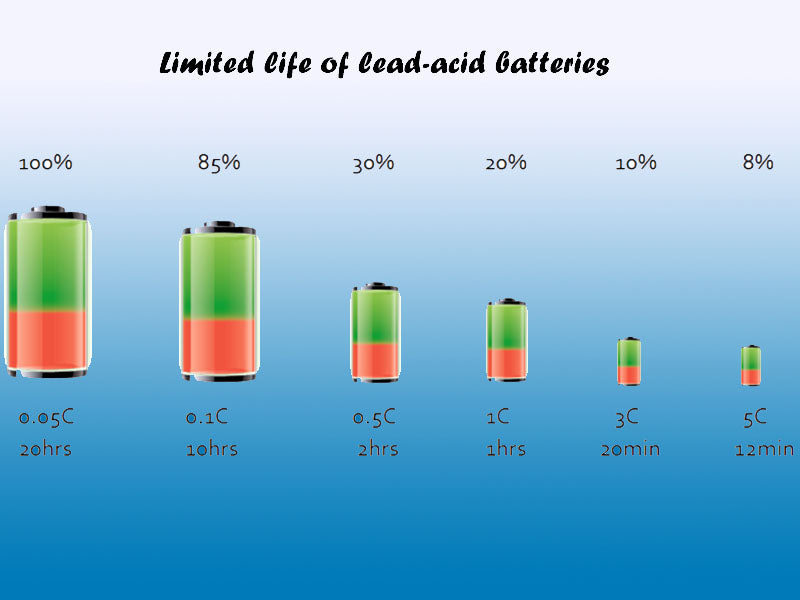
Due to their particular sensitivity to operating conditions, lead-acid batteries typically have a shorter and less predictable lifespan when used in outdoor environments than in some specialized applications such as stationary energy storage plants or automobiles.
In the photovoltaic power generation system, some special failure phenomena will occur in the battery, which will lead to its performance degradation, including:
(1) The electrolyte stratification produced by the daily cycle of the battery (a small part of the electrolyte in the battery is highly acidified).
(2) Due to the over-discharge of the battery and the stratification of the electrolyte, the positive and negative electrodes of the battery will undergo sulfidation, which in this case will lead to the deposition of lead sulfate on the substrate of the electrode.
(3) Cathodic corrosion due to battery overcharge and high temperature operation.
(4) The active material falls off, especially for batteries with flat electrodes.
The failures of the above-mentioned batteries will limit life of lead-acid battery.Is there any way to improve the problem of limited life of lead-acid batteries? Please see the following two points.
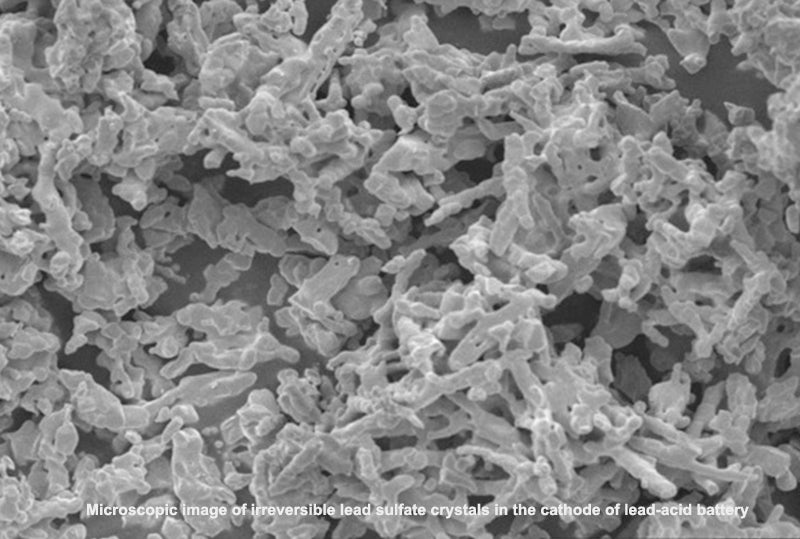
1. Battery energy management

In a stand-alone photovoltaic power generation system, since the charging of the battery is limited by the amount of sunlight at that time, the energy management system becomes critical, not only to ensure the normal power supply to the user, but also to make the life of the system reach the expected number of years.If the stand-alone photovoltaic lighting system is not properly managed, it is easy to cause the problem of limited life of lead-acid batteries.
The energy management system is implemented by a regulator to adapt the state of charge of the battery to its technical performance. At present, most of the regulators on the market are designed for lead-acid batteries, and rarely for Jin-cadmium batteries. The formulation of the regulator operating strategy is generally based on the measured battery voltage and current values.
The most common operating principles are based on four different voltage thresholds, namely, HVD (high voltage disconnect) to stop charging; LVD (low voltage disconnect) to stop discharging; the middle two voltage thresholds are used for reconnection after battery disconnection: HVR (high pressure reconnection threshold), LVR (low pressure reconnection threshold). The determination of the voltage threshold is related to the capacity of the system.
The energy management strategy is divided into two categories: daily management and regular management, the latter is used for battery performance recovery after a period of operation.
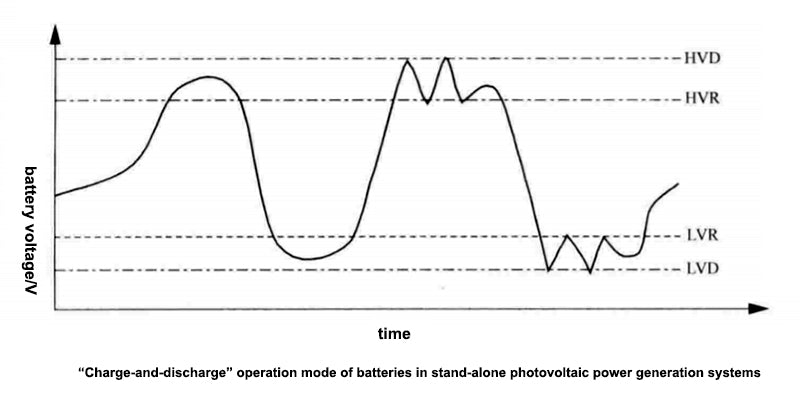
The following are several strategies for daily management;
1) "Charge-and-discharge" management mode. This is the most basic management strategy, disconnecting when the battery voltage reaches a certain threshold, and reconnecting when the battery voltage returns to normal and reaches the reconnection threshold. The figure illustrates the role of the high-voltage cut-off value on the battery in daily management and the impact of different threshold selections on the system.
2) "Floating charge" management mode. When the high voltage disconnection value is reached, the system still maintains a much lower current than the "non-charge-and-discharge" mode, which is used to charge the battery and keep the battery voltage constant. In this mode, the high-voltage reconnection threshold HVR does not work.
3) "Pulse charging" management mode. Some regulators using new power electronics technology can control the charging current of the battery so that it charges and rests according to a certain period.
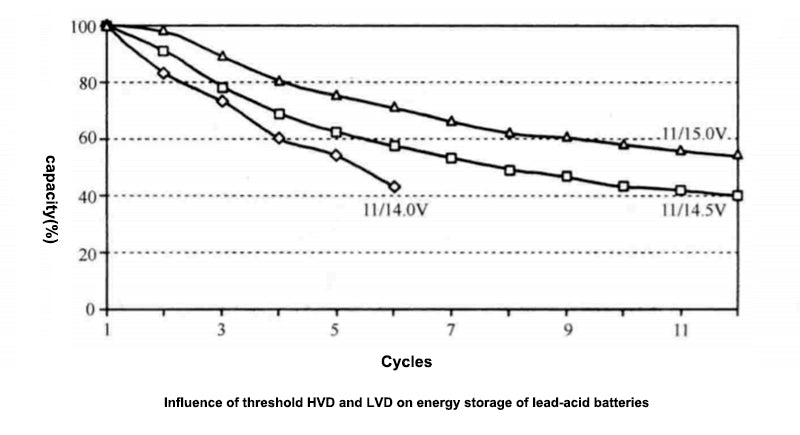
Doing a good job of the above daily management strategies can effectively improve the problem of limited life of lead-acid batteries.
The advantages of such pulsed charging of batteries have been demonstrated several years ago, including the ability to limit the occurrence of electrolyzed water and increase the efficiency of charging. The main issues of this strategy are the optimization of the modulation signal (including pulse frequency and duty cycle), and how to slow down the electrochemical failure process of the battery. The relevant test results will promote the marketization of this optimized charger in the next two years.
The regular management of batteries in stand-alone photovoltaic systems is to improve the charging process of batteries by temporarily increasing the HVD threshold of batteries with a rated voltage of 12V from 14.4V to 14.8V. This approach, known as "enhanced charging," is especially useful for lead-acid batteries, where it aims to improve the battery's charge acceptance and reduce electrolyte stratification. This also avoids water loss and corrosion of the positive grid due to frequent overcharging.
Different battery charge regulators have different implementation cycles of "enhanced charging": some are only used for the initial charge of the battery, some are performed periodically (such as weekly or every 10 days), or manually set by the user. The disadvantage of this method is that the photovoltaic system may experience uncontrollable power situations, that is, when the "enhanced charging" is first carried out, the required power may not always be available.
Finally, a major factor is the identification technology of battery state of charge and state of health. Regulators will become increasingly intelligent, giving information about the battery's current available charge ("state of charge" SOC), or total available capacity ("health state" HOC). This information is very useful to the user and is equally important to improve the overall intelligence of the photovoltaic system and prolong the life of the battery.
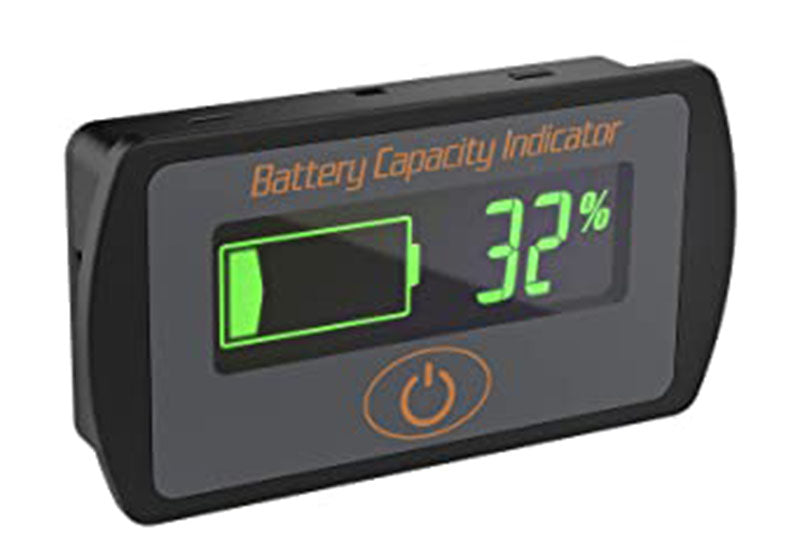
2. Promising lithium ion battery technology
In the stand-alone photovoltaic power generation system, which energy storage technology has the development prospects in the future?
For the problem of limited life of lead-acid batteries, we will no longer be limited to just maintaining lead-acid batteries. The development of new new energy lithium-ion batteries is also a new direction to solve the problem of limited life of lead-acid batteries. Lithium-ion batteries have many advantages that lead-acid batteries do not have. The most obvious advantage is that the service life of lithium-ion batteries is much longer than that of lead-acid batteries. The market for lithium-ion batteries will become more and more broad in the future, which can be very good. It solves the problem of limited life of lead-acid batteries.
A variety of different energy storage technologies have been tested (lead-acid batteries, cadmium batteries, lithium-ion batteries), and the results show that lithium-ion batteries have great potential in photovoltaic power generation applications when cycle life is considered,this means that lithium-ion batteries will not suffer from the life-limiting problems of lead-acid batteries. . Lithium-ion batteries also have several other performance advantages, such as high energy storage efficiency, long service life, maintenance-free, high reliability, and predictable performance. Cost is the main limiting factor for Li-ion batteries, but it seems to be falling (in hybrid or electric vehicle applications, the cost of Li-ion batteries has dropped to 1/4 of the original in the past few years), so Li-ion battery technology In the next few years, there will be a wider range of applications.
In the past two or three years, some research projects have been devoted to the application of lithium-ion battery energy storage to photovoltaic power generation. The battery modules of tens of ampere hours are used in the system, and the configuration capacity of the batteries in these photovoltaic power generation systems has been optimized and adjusted. and management mode.
In the power supply application of special equipment (such as marine beacon lights, street lights), lithium-ion batteries have a certain competitiveness, which benefits from the high reliability of lithium-ion batteries and the cost advantage of about 0.2 euros/kW.h ( The cost of lead-acid batteries is 0.5 to 2 EUR/kW h).
Lithium-ion battery technology is also likely to achieve a lifespan of energy storage devices comparable to that of photovoltaic power generation systems, ie 20 to 25 years.
To sum up, the problem of limited life of lead-acid batteries will be greatly improved in the future, and we look forward to the broad development in the battery field in the future.